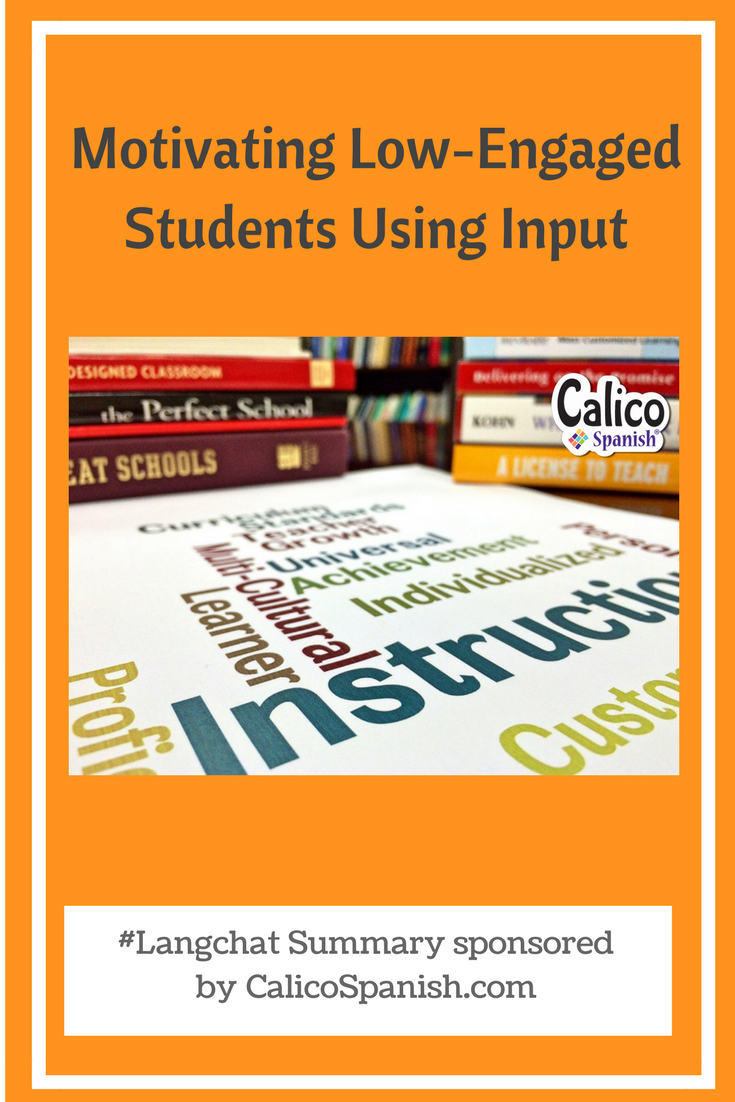Motivating Low-Engaged Students Using Input
 #Langchat teachers held a discussion on appropriate and effective input to motivate low-engaged students. They shared useful strategies and advice for teaching the low-engaged student.
#Langchat teachers held a discussion on appropriate and effective input to motivate low-engaged students. They shared useful strategies and advice for teaching the low-engaged student.
– Follow the blog on Bloglovin –
Engaging Forms of Input
#Langchat participants began the conversation by sharing some of their most successful forms of input used to engage students. Total Physical Response lessons are always a good place to start when seeking participation from low-engaged students. @kclarkwny said, “My students love hands-on or game-type activities.” Finding input that students are interested in or are able to relate to is helpful in engaging them in the classroom. @jfh1790 shared, “The name of the game is context! Young ears only perk up when they hear something of interest. [Students] need context to focus.” @SrtaOlson said, “The authentic materials engage [students] the most! Give them the culture!” Engage students with “personalized or customized input.” (@welangley). Technology, songs, music, and movies are all popular among students. @JElderGCC “Found that [students] are engaged with songs and music. [They are a] great and easy way to incorporate content.”
– Like Calico Spanish on Facebook –
Teacher Strategies to Engage Students Aurally
Using audio input is a great way to engage students. #Langchat teachers shared the following classroom techniques to motivate low-engaged students through auditory-focused activities.
- @SraWilliams3 said, “Edpuzzle has been a useful tool with audio input.”
- @CHSSraHale shared, “Whenever I do a music/song lesson I intro the [students] to the artist with a jigsaw/video/autobiography activity. [It] gives them context.”
- @JElderGCC said:
Include hand motions and gestures with audio. [We] learned body parts in Spanish by tapping the appropriate part when song was on.
- @SRARoblesHHS shared, “[Students] love a cloze activity with an authentic, hip song in the [target language]. I love recycling older grammar and vocab with it too.”
- @MmeCarbonneau’s “novices need visuals and pre-listening scaffolding activities in order to focus their brains to listen well.”
- @joyeuse212 suggests “using @nearpod, @flipgrid, and/or @padlet.” to engage students.
Introduce a child you love to a lifelong journey of speaking real Spanish to real people. Click the red button to experience it FREE.
Teacher Strategies to Engage Students Through Written Input
#Langchat teachers also shared how using written input can engage students in both similar and different ways than aural input. The following strategies were shared.
- @sharon_grele suggests that students “read, discuss with table group, and then [participate in] class discussion. Helps build confidence with [small] group.”
- @MmeCarbonneau shared, “Just like listening, lots of images, pre-reading activities, scaffolding and make sure it is of high interest and relevant.”
- @srafischer said, “I LOVE having them do chat stations for short bits of info. Gets them walking and talking.”
- @seniorita_leake suggests “finding familiar concepts & vocab with highlighting and circling etc.”
- @CHSSraHale said, “Let them help each other and play to each other’s strengths. Hyperdocs people, trust me.”
– Follow Calico Spanish on Twitter –
Counteracting Outside Issues that Lower Engagement
There are many sources of distraction in the world language classroom. Many distractions stem from student’s home lives, school activities, sports, or social drama. “All things Social-Emotional affect [student] engagement. We should know our [students] well enough that we recognize when it’s an off-day” (@kellycondon). @ADiazMora shared that “phones, drama with friends and family” can affect a student’s “motivation for being in class.” According to @SraSpanglish, teachers can begin to counteract these issues by “listening. We begin with listening. I get a lot further if I cut out time to let a kid vent about other stuff [before] asking for [homework].” @JElderGcc suggests that teachers “Give [students] a chance to let out the drama and issues through writing or a project that uses vocab from class.” @sharon_grele said, “keep it fun. [High school] students love to be silly, even seniors in the fourth quarter like goofiness.” Thankfully, “the beauty of our classes is we can use ANYTHING as a prompt for conversation” (@welangley).
– Follow us on Instagram too! –
Giving Feedback on Progress
Giving low-engaged students better feedback on their progress during the input phase has proven to increase their motivation. “[Students] need to know this learning is not just for a grade or to make teacher happy. When we connect with them, they care!” (@CatherineKU72) @senorita_leake said, “reinforce what [students] did do and give tips on improvement.” @doriecp shared, “having them monitor their own input works well for me.” For example, using “sticker charts for the [number] of books read. My littles love stickers!” Teachers can have an incredible impact in the lives of their students. “Making eye contact and letting [students] know you care – these can make such a huge difference” (@lushluxe).
Thank You
Your participation and involvement makes #langchat possible! Thank you for joining the conversation. Thank you to our lead moderator, Laura (@SraSpanglish) for guiding the conversation on Motivating Low-Engaged Students Using Input. Have a theme or question you would like to discuss? Please submit your ideas to the #langchat wiki!






No Comments